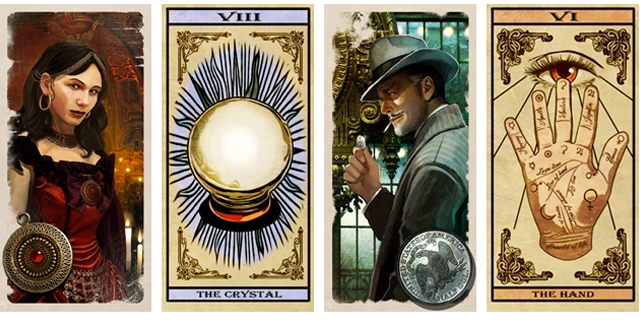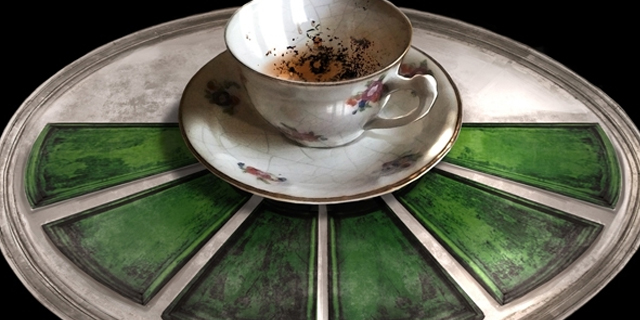
Quick-playing card games with deceptively simple mechanics are always welcome at my gaming table. My latest acquisition, Brett J. Gilbert’s Divinare (published by Asmodee), is a fascinating mix of bluffing, treachery, and strategy flavorfully disguised as an international tournament of psychics and mediums.
The object? To predict the contents of your opponents’ hands and accurately anticipate the cards that have been dealt each round. The deck consists of 36 cards divided unevenly into four colors (six red, eight blue, ten green and 12 yellow), only 24 of which will be dealt out each round. On your turn, you have to play one card from your hand and then move your prediction marker on that color’s board to any unoccupied space (or to the non-scoring center area).
The catch? You must move your marker whenever you play a card, even if it is already where you want it to be! This is really the heart of the game, as you must carefully balance your desire to lock down what you hope is an accurate prediction without being forced to move off it at an inopportune moment.

Now, you aren’t just guessing blindly here. At certain times during each round, including the very start of each round, you will pass half of the cards in your hand to the player on your right and receive the same from the player on your left (playing with two players features an additional wrinkle), which adds to your information. Choosing which cards to pass can be crucial, especially when it comes to the final pass of the round, since you must decide which of the cards in your hand you will be forced to play… as well as which cards in your hand you will be forcing your neighbor to play. This can and will throw some serious wrenches in even the best-laid plans.
Once all cards have been played, the predictions are scored. An exact prediction one a given color earns three points. A prediction one space above or below the exact prediction will earn one. All other predictions (that is, markers not on the center area) are penalized one point. At the high and low extremes of each board are bonus spaces that provide one or two additional one-point bonuses — or penalties — if your marker is there at scoring time. The highest score after a number of rounds equal to the number of players is the winner.

That’s it, really. Pass cards, play cards, predict cards. You have no idea what will be passed your way, so you have to place your markers carefully. Make an accurate guess too early and you might be forced to move off. Make a bluff too soon and you might not be able to move where you really want to be in time (or at all). Haven’t made a prediction on a color yet, everyone else is occupying the best spaces, and you get passed a card in that color on the final pass? Sucks to be you! Try to minimize the damage if possible.
Divinare rarely lasts more than half an hour per session, and it is so simple to teach that there’s basically no learning curve. While it can be a little random (it is a card game, after all), you will have to temper your luck with some keen strategy if you really want to succeed. Every choice you make can have consequences, but sometimes you won’t discover exactly what those consequences are until it’s too late. For an MSRP of around $25 you can’t usually ask for too much, but Divinare will provide value well beyond its humble price tag.



















